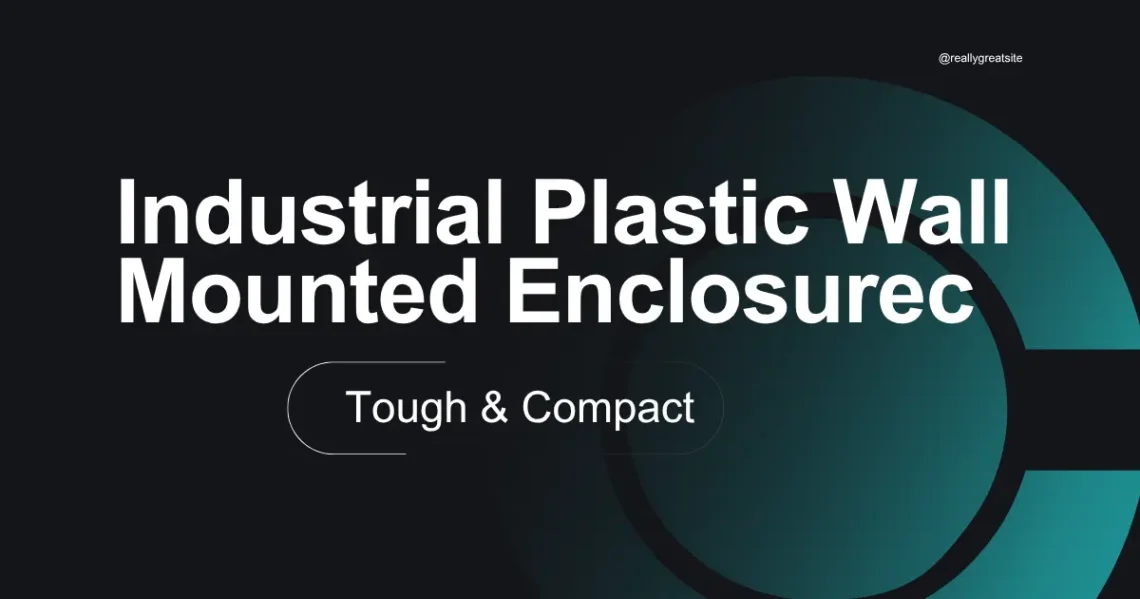Introduction to Industrial Plastic Wall Mounted Enclosures
Alright, let’s start simple—what exactly is an industrial plastic wall mounted enclosure? Well, think of it as a tough little box that protects important electrical or electronic components in rugged environments. You’ll usually find them clinging to factory walls, power stations, warehouses, or even outdoors braving the elements. They might look plain on the outside, but inside, they’re doing a serious job—keeping things safe, dry, and secure.
Now, why go for a wall-mounted one? Good question. Space, for starters. Mounting enclosures on a wall gets them off the floor, out of the way, and neatly out of danger zones—especially in busy areas with heavy machinery or foot traffic. You save room, reduce hazards, and make maintenance way easier.
And why plastic? Some folks immediately think “metal is stronger,” which… sure, in some cases, that’s true. But industrial-grade plastics have come a long way. The right polycarbonate or ABS plastic can take hits, survive intense temperatures, and resist chemicals better than you’d expect. Plus, they’re lightweight and usually cheaper than their metal counterparts.
Another thing is that they’re non-conductive. That’s a big plus when you’re dealing with live wires or sensitive electronics. No accidental shocks, no grounding issues—just solid insulation baked right into the material. It’s kind of genius when you think about it.
So yeah, these enclosures might not be glamorous, but they’re quiet heroes in the industrial world. Whether you’re protecting a power distribution block or just keeping out dust and water, a compact, tough plastic box on the wall might be doing more work than you’d ever imagine.
Key Features That Make Them Tough & Compact
Now, let’s break down what makes these industrial plastic wall mounted enclosures both tough and compact—two words that sound simple, but actually mean a lot in industrial settings.
First off, material matters. Most of these enclosures are made from high-grade plastics like polycarbonate, ABS, or fiberglass-reinforced polyester. What’s cool about these materials is that they’re lightweight but incredibly durable. You could smack one accidentally with a wrench (we’ve all done it), and it’d probably just shrug it off without even cracking. Try doing that with cheap plastic… yeah, no thanks.
And then there’s the impact resistance. These boxes are often rated to withstand high levels of physical stress—think of it like armor for your electronics. In places where bumps, knocks, or vibrations are just part of the daily grind, that kind of toughness is priceless.
As for the compactness, that’s where the wall-mount design really shines. These enclosures are often slim, efficiently shaped, and built to hug walls without taking up too much room. You won’t find fancy curves or unnecessary bulk—just smart, clean lines designed to keep things protected without being in the way. Perfect for tight industrial spaces where every inch counts.
Also worth noting? IP ratings. Most of these enclosures are dust-tight and water-resistant (like IP65, IP66, or even IP67). That means your gear stays safe from rain, dust storms, or accidental hose-downs—which, let’s be real, happens more than anyone admits.
So, tough? Absolutely. Compact? You bet. And all that wrapped in a piece of plastic? It’s kind of incredible how something so small and simple can offer so much protection and flexibility.
Common Applications in Industrial Environments
You know, it’s easy to look at a plastic box on a wall and think, “What could that possibly be doing?” But in the world of industrial setups, these wall-mounted enclosures are working overtime. They’re the silent bodyguards for electrical systems, communication networks, and even automation controls.
One of the most common uses is housing electrical junctions and distribution boards. Imagine a noisy, dusty factory floor with forklifts zooming by. The last thing you want is exposed wiring or delicate terminals just sitting out in the open. That’s where these enclosures come in—keeping everything protected from bumps, dust, and the occasional splash of something you really don’t want touching metal contacts.
They’re also heavily used in automation control systems. Think sensors, PLCs, relays—all that good stuff. These components can’t just hang around in the open air. They need a safe, dry home, and wall-mounted enclosures provide just that without eating up floor space.
Warehouses, production facilities, mining sites, agricultural setups, even renewable energy projects—you name it, they’re there. Outdoor use is super common too. With the right weatherproofing, these enclosures can handle rain, dust storms, and temperature swings like champs. And yes, you’ll even find them mounted on poles, fences, or utility walls, silently protecting communications gear or power supply units.
A lot of companies also use them for low-voltage control systems, surveillance camera wiring, and network junctions. Basically, anywhere you’ve got sensitive components and a not-so-gentle environment, you’ll find one of these enclosures standing guard.
They’re easy to miss—but they’re everywhere. And once you start noticing them, you’ll realize just how important these compact plastic boxes are to the infrastructure that keeps industries running smoothly.
Choosing the Right Enclosure for Your Needs
Alright, let’s be honest—shopping for an industrial enclosure doesn’t sound all that exciting. But if you pick the wrong one? Oh boy, you’ll know. Overheating, busted seals, wires crammed like spaghetti… it becomes a nightmare. So, choosing the right wall-mounted plastic enclosure? Yeah, it matters—a lot.
First up: size really does matter. You want enough space for your components, plus a little breathing room. Don’t try to stuff a dozen terminal blocks into a tiny box—it’ll just make installation a mess and maintenance a headache. Always measure your gear first. A tight fit might look clean at first, but cables need space to bend and air needs room to flow.
Next, think about load capacity and mounting options. If the enclosure’s going on a vibrating machine or outdoors in the sun all day, you’ll want something that won’t crack under pressure. Look for wall brackets that are reinforced and models that are rated for mechanical stress or UV resistance.
Another key thing? Cable entry and exit options. Some enclosures come with knockouts or rubber grommets, while others let you drill your own holes. Just be sure the seals are tight—especially if you’re dealing with moisture or dust-prone environments.
Don’t forget to check the IP rating. IP65 is great for basic water and dust resistance. If you’re dealing with jet sprays, outdoor rain, or industrial cleaners, go higher—like IP66 or IP67. Seriously, this isn’t the part to cheap out on.
And finally, look at certifications. UL-listed, CE-compliant, RoHS-safe—these labels might seem like technical fluff, but they’re peace of mind, especially in regulated industries.
In short? Don’t rush it. Picking the right enclosure is about more than looks—it’s about reliability, protection, and not getting yelled at during an inspection.
Installation Tips for Maximum Performance
Alright, so you’ve got the perfect industrial plastic wall mounted enclosure picked out. Feels good, doesn’t it? But now comes the part that can make or break its performance—installing it right. A great enclosure won’t do much if it’s mounted poorly or left vulnerable to dust, water, or even just time.
First things first: location matters more than you think. Before you start drilling holes into walls, step back and take a look. Avoid placing the enclosure in spots where water might pool or where it’s constantly exposed to direct sunlight (unless it’s UV-resistant). Also, stay clear of vibrating surfaces unless the enclosure is designed to handle that.
Next up: mount it properly. Use the mounting holes provided—don’t try to DIY your own unless you absolutely know what you’re doing. Using the wrong type of fasteners or mounting it unevenly can put stress on the plastic over time. Not to mention, it just looks sloppy.
Also, make sure the cable glands or entry points are sealed tightly. This is where a lot of mistakes happen. People drill out holes for wires and then forget to seal them properly. Moisture creeps in, dust builds up, and before you know it, the inside of your enclosure looks like a mini sandbox.
It’s also smart to think about ventilation, especially if you’re installing electronics that generate heat. Some enclosures come with optional vents or can be paired with small fan kits. If not, you might want to rethink placement or airflow.
Lastly, plan for maintenance. You don’t want to unmount the whole box just to tighten one terminal screw. Install it at a reachable height and leave room around it for your hands—and maybe a flashlight when things go wrong (because they always do, eventually).
Pros and Cons of Plastic Industrial Enclosures
Alright, let’s call it like it is—plastic enclosures are kind of the unsung heroes of industrial environments. But like anything else, they’re not flawless. They’ve got strengths, for sure, but also a few quirks that might not suit every situation. So let’s break it down, no sugarcoating.
The Pros First (Because They’re Worth Noticing)
Top of the list? Non-conductivity. Plastic doesn’t carry current, so it’s automatically safer for housing electrical components. You won’t need grounding like you would with metal boxes, and that’s one less thing to worry about during install.
Then there’s weight. These enclosures are light—like really light. You don’t need heavy-duty mounting hardware, and they’re way easier to handle, especially if you’re installing multiple units in a row.
They’re also corrosion-resistant, which is huge in places with humidity, chemicals, or salt in the air. While metal might rust or need coatings, plastic just… exists. Quietly. Unbothered. It doesn’t care about moisture or harsh cleaning agents.
And finally: price. In most cases, plastic is cheaper. If you’re working on a budget or need a bunch of enclosures, you’ll save some serious cash going plastic.
But There Are Cons, Too
One of the biggest? Heat sensitivity. Plastic doesn’t always handle high temps well. In places where electronics run hot or the sun’s blazing, you’ll want to choose your material carefully—maybe even add ventilation.
And while durable, plastic isn’t impact-proof. A strong enough knock (especially at the wrong angle or in cold weather) can crack it. It’s not flimsy, but it’s also not invincible.
Also, it can sometimes age poorly—UV exposure may cause yellowing or brittleness over time if the plastic isn’t UV-stabilized.
So yeah, plastic enclosures? Pretty great for most jobs. Just know what you’re working with—and around—and they’ll more than earn their spot on your wall.
Conclusion
So, there it is—the low-key powerhouse that is the industrial plastic wall mounted enclosure. Not the flashiest thing in the room, but man, it pulls its weight. Whether you’re dealing with electrical gear, automation systems, or just trying to keep some sensitive components clean and safe, these tough little boxes get the job done quietly and efficiently.
What makes them such a solid choice? Well, they strike a rare balance: tough but light, protective but compact, and cost-effective without being cheap. In spaces where metal might be overkill—or frankly, a pain to deal with—plastic steps up and proves it’s more than just a budget alternative.
Of course, they’re not perfect. Nothing really is. They’ve got their limits—especially with heat or physical abuse—but when chosen thoughtfully and installed properly, they’ll last longer than you’d expect. And the convenience? Hard to beat. From quicker installs to easier modifications, they just make life a little less complicated.
So whether you’re upgrading a control room, setting up a small server hub, or just looking for a weatherproof case for some critical wiring, don’t underestimate what a good plastic wall mount enclosure can offer. It’s a small choice that can make a big difference in long-term reliability, safety, and peace of mind.
And hey—next time you walk into a factory, warehouse, or server room, take a glance at the walls. You’ll probably spot a few of these unsung heroes doing their thing, silently holding everything together behind the scenes.
FAQs – Industrial Plastic Wall Mounted Enclosure
Q1: Are plastic wall mounted enclosures strong enough for industrial use?
Yes, absolutely—if you choose the right material like polycarbonate or fiberglass-reinforced plastic. They’re designed to withstand impacts, harsh environments, and regular use. Just make sure the model has the appropriate IP rating and certifications.
Q2: Can these enclosures be used outdoors?
Yes, many are built for outdoor use. Look for enclosures with IP65 or higher, and materials that are UV-stabilized to avoid sun damage. Always double-check the specs if the environment is extreme—like high humidity or salt air.
Q3: How do I know what size enclosure I need?
Measure the components you plan to install and leave extra space for wiring, air circulation, and any future upgrades. Too small, and it’ll be cramped. Too large, and you’re wasting space and money.
Q4: Are plastic enclosures safer than metal ones?
In many cases, yes. Plastic is non-conductive, so there’s less risk of accidental shock or grounding issues. That said, it depends on the use case—some high-voltage or heat-intensive setups may still require metal.
Q5: Can I drill holes or cut openings in the enclosure?
Yes, most plastic enclosures can be drilled or modified fairly easily. Just go slow, use the right tools, and make sure any new openings are sealed properly to maintain the weather and dust protection.





